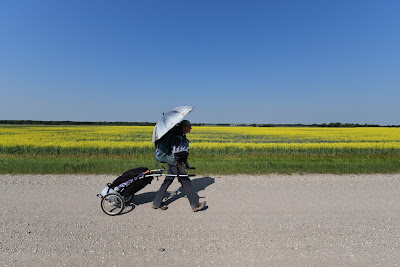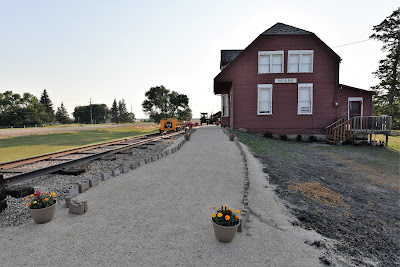Dino and Dana Meise : Morden to Miami
Since southern Manitoba was under an extreme heat warning today, with temperatures expected to reach 29°C by 9:30 am, we headed out onto the trail early - around 4:30 am. The sky was still dark as we made our way back through downtown Morden, heading straight for the Tim Horton's, which promised to remain open 24 hours. To make a long story short, and skip a few internal curses, only the drive-thru was open, and you very definitely needed a motorized vehicle to obtain service through the magical window. Feeling rather glum, we set out down the gravel concessions to retrace our steps and rejoin the Trans Canada Trail.
As the red sun rose in the sky, casting its golden light across the fields, we found ourselves walking among pastures filled with multi-coloured cows. Their black, reddish brown, and light tan forms were scattered among the small shrubs and scrappy bushes, and we spotted a few sets of ears poking out above the deep dry grass.
There were large, modern homes dotting the concessions as well, and we spotted a White-tailed deer grazing in someone's front yard. A Lesser Yellowlegs perched precariously on a wooden fence post, and a Brown Thrasher foraged on their front lawn. Overhead a noisy flock of Barn Swallows wheeled and dove for insects. As we continued past the houses an Upland Sandpiper ran down the road ahead of us, doing it's best to distract us from the fuzzy little baby running along behind it.
Today's trail section began with a small climb into the hills, and then we found ourselves walking along flat concessions parallel to a forested ridge. In the past couple days we've noticed that the landscape has become more hilly, and today we learned that this is because we are walking through the Pembina Hills, on the edge of what was once Lake Agassiz. This large glacial lake once covered an area larger than all the Great Lakes combined. Around ten thousand years ago, a raging glacial river dropped sand and silt on the prairies in this area before emptying into Lake Agassiz. It also deposited debris, forming the rolling Pembina and Tiger Hills in this area. The Assiniboine Delta, which we will be hiking through in the coming days, was created in the process as well. As we walked along, we were essentially looking at what was once the shoreline of Lake Agassiz.
Around 11 am, when it was really starting to get hot, we met Dino, a very friendly farmer who remembered hosting Dana Meise a few years ago. He said he offered Dana a place to stay, but Dana insisted on walking to Miami in the midst of a tremendous thunderstorm before being picked up, because he followed the rule of never accepting a place to stay ahead of his position on the trail, only behind. Now that's dedication!
Dino told us that his family pioneered their farm in 1870, about 10 years
before Morden was founded in 1881 in what is now Nelsonville. Apparently
we had just passed a cairn on his farm marking the spot where his ancestors
spent their first winter in a sod hut and their overturned wagon. He suggested
we detour slightly to visit a cairn marking the spot where Nelsonville had
originally been, and then to visit a restored chapel a little ways down the
road.
We took his advice and found ourselves in front of a large stone marker with a
plaque in a beautifully shaded pull-off at the intersection of two
concessions. The plaque indicated that we were at the town site of Neslonville,
which was there from 1877 to 1885. Apparently Adam Nelson built a grist
mill at the site in 1877 and five years later over 1000 people lived in the
incorporated town, which had a land titles office, a newspaper, and was a
regular stagecoach stop. In 1883 the train line was put in, bypassing
Nelsonville. Most of the residents relocated their homes to Morden or
other communities serviced by the train, leaving Nelson a virtual ghost
town. Dino said he is now 'Mayor of Nelsonville' because he is it's only
resident.
As we savoured the shade of the historic site, and watched a Red-bellied Sapsucker foraging for insects on the trunk of an ash, a very friendly cyclist stopped for a chat. Like many Manitoban's we've spoken with, he was familiar with the route of the Trans Canada Trail in this area, and he said he cycles a 50 km loop every weekend in the area. He was very supportive of our hike, and took our photo before wishing us well and heading out.
A couple minutes later Dino drove by in his truck again, and stopped to show us a survey map of the original town site, as well as the original land deeds his family received when they immigrated from Ireland. He was very proud of his past, and it was really cool to meet such an interesting living link to the history of this beautiful place. It would have been amazing to spend more time learning from him.
While we chatted he also mentioned the drought. He told us that this region of Manitoba didn't receive any snow this past winter, and they've received only about 40% of their normal amount of rain. Apparently it hasn't been this bad since 1988 - 89. The creeks didn't run in spring, and now the dryness runs deep into the soil. He was off to bale his hay, but he said the second harvest would be virtually non-existent because the grass is now dry and crispy, and there is pretty much no hope of rain. He also spoke about being a guide for fishermen, duck hunters, and sportsmen up in the Yukon and down in Mississippi, but with Covid all those activities have been put on hold. It sounded like his whole livelihood was in jeopardy, but he wasn't complaining. All he said was "That's the way that goes." We admire this no nonsense attitude, and his deep knowledge of the land and the area.
After a long chat we headed off down the concession in the now very hot sun. Of course we stopped at the Dunston Church. This simple white chapel was built in 1895 and has been beautifully restored. It was open, and we were able to go inside and sign the guest book, and admire the wooden benches and organ. We particularly enjoyed the multi-coloured and patterned panes of glass in the doors. Again, it is still in use today, providing a living link to the past.
After this beautiful visit we had about 16 kilometres of concession walking to reach Miami. We passed blooming yellow canola fields and sunflower fields with one or two golden flowers already opening in a sea of green leaves. We stopped to admire the red wooden barns and took many breaks in the shade of roadside trees. During one of these pauses we could hear the loud buzzing of bees, and when we walked onward we discovered a very large pile of bee boxes!
We followed concessions until the trail turned to a dirt track. We met another farmer going in to town of his ATV who stopped to chat with us well. Finally, we followed a beautiful rail trail in to town.
When we reached the outskirts of Miami we stopped in the shade of some tall trees bordering a cemetery. There was a colony of ground nesting bees, and many of them stopped to drink from our sweat soaked shirts. The wildlife out here really seems to be desperate for moisture, and sitting on dry, cracked, hard-as-concrete soil we can understand why. The only mystery is how the corn, soy, and canola crops remain lush and green.
When we arrived in Miami we found a beautiful municipal campground with shady trees, picnic tables, and beautiful landscaping. Best of all, it had cold showers and running water! We gratefully set up our tent, chatting with the campground owner as we went. She too was familiar with the trail in this area. Although we had lots of work to do, we spent quite a bit of time standing under cold showers in an effort to cool off.
Our next stop was the Miami Variety Store. Several people had mentioned this place to us today, suggesting it sold everything, including ice cream and delicious homemade deli sandwiches. It turned out they were right! The shop is crammed with everything imaginable, and the friendly owners and their delicious sandwiches lived up to their stellar reputation and more! We enjoyed soft ice cream, cold drinks, and tasty sandwiches while relaxing in a lovely campground. If every day could end like this we'd be in heaven!
We explored the beautifully landscaped and flower-filled Rural Municipality of Thompson Memorial Garden, and walked down to the beautifully restored Railway Museum, which is located in the old train station. The station was built in 1889 and is a rare surviving example of the Northern Pacific and Manitoba Railway stations that were built for many years by the Canadian Northern and the Canadian National Railways.
The campground is on the main street of the tiny town, wedged between a quiet neighbourhood on one side and the highway on the other. On the far side of the highway is a huge stadium with bleachers, a large curling arena, and a community centre. A baseball diamond sits in the field in front the bleachers, and a horse racing track circles it, which was being actively used as we watched. Although I'm sure it is the butt of many pranks and jokes having to do with its Florida namesake, this really is a beautiful little community!












































This comment has been removed by the author.
ReplyDeleteIt was awesome to meet you two!! It made me smile to be remembered as the “very friendly cyclist”. I would’ve loved to spend more time with you but I look forward to following your adventure online. God bless your travels.
ReplyDelete